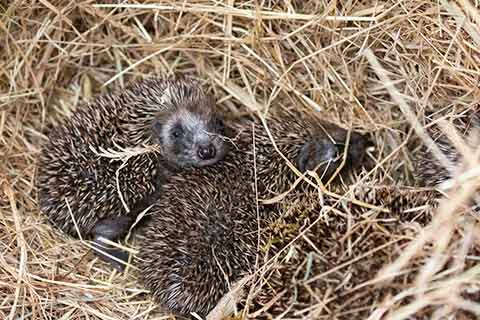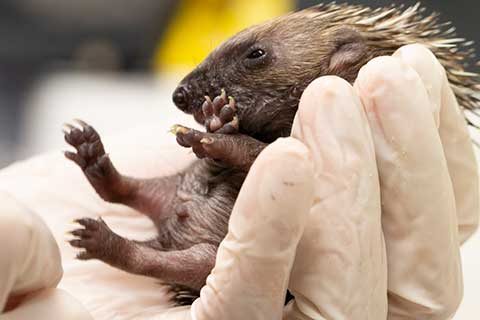Baby hedgehogs
Baby hedgehogs are called hoglets. If you find a hoglet on their own it's usually best to leave them alone as their parent is probably close by. Find out when it’s time to help.

When do hedgehogs breed?
Hedgehogs breed in Spring and Summer, mostly during May and June. Both male and female hedgehogs can mate several times a year with multiple partners. Litters usually consist of around four or five hoglets.
Hoglets are born blind and deaf, and their spines are pure white when they first appear soon after birth. They'll start leaving the nest to forage with their mother around four weeks old and will be independent by about eight weeks old.
Found a baby hedgehog?
If you find a hoglet during the day they may need rescuing. Check the surrounding area to see if there are other hoglets as there are usually four or five in a litter.
Watch from a safe distance and only intervene if the hoglet is:
- In immediate danger
- Squeaking with eyes shut or huddled together with other hoglets in the open, without an adult nearby
- Next to a dead adult
- Weighing less than 300g (about the size of an apple) without an adult nearby
- Out during the day when it’s very cold
- Sick, injured or surrounded by flies
Young hedgehogs larger than an apple and seen at night should be fully weaned and ready to be independent of their parents so should be left alone.
Found a hoglet from October to February
Although, hoglets are usually born in the summer mothers can have a second litter born as late as September or October. This isn't long before hibernation starts.
Hedgehogs born this late in the year might not have enough fat reserves to survive the long winter hibernation without some help. Often, they'll have to forage for longer to find enough food so they might be seen out during the day.
The best way to help the young hedgehog will depend on how much it weighs:
- If the hoglet weighs less than 300g (about the size of an apple), it will need specialist care to survive the winter.
- If the young hedgehog weighs between 300g-450g (about the size of a mango), is only seen at night, and it's before mid-October with mild weather, you can provide food in the garden. Monitor its weight, and if it's not gaining weight or you're still seeing it when the weather gets colder, please contact a vet or wildlife rehabilitator for advice.
- If the young hedgehog weighs between 300g-450g (about the size of a mango), after mid-October, they probably won't have enough weight to see them through the winter, so may need more help. We recommend following the British Hedgehog Preservation Society advice for autumn juvenile hedgehogs, which describes how to help them over the winter.
- If the hedgehog weighs over 450g (larger than a mango) and is only seen out at night, it should be healthy enough to hibernate as normal in the wild. They'll be foraging for food overnight, so if you can, keep providing food in the garden, as this will help them to put on even more weight before hibernation.
- If the hedgehog is sick or injured or seen out during the day during cold weather, follow our advice.
Found a hoglet in Summer
If you spot a young hedgehog larger than an apple out during the day but who isn’t obviously sick or injured then watch from a distance. It’s always helpful to try offering them food and fresh water. If the young hedgehog doesn’t eat the food, doesn’t leave the area or has flies around it, or you’re still concerned about it, please contact your nearest wildlife rescue centre. For an injured baby, in the daylight or night, the best thing you can do it take it to a vet.

Video: How to transport small mammals
What do young hedgehogs eat?
You can try offering food to a young hedgehog, but make sure you feed them something suitable:
- Tinned dog or cat food - cat biscuits or crushed dog biscuits, make good hedgehog foods. You'll need to soak the biscuits in water first to make it easy for the hoglet to eat.
- Good quality, specialist hedgehog foods - these can be bought from wildlife food suppliers.
- Soak biscuits in water for very young hoglets that weigh less than 300g, as they can't eat dry food.
- Never give cow's milk to hedgehogs, as it can give them diarrhoea.
- Don't feed them bread, as it's low in nutrients.
- Only offer them fresh water to drink.




